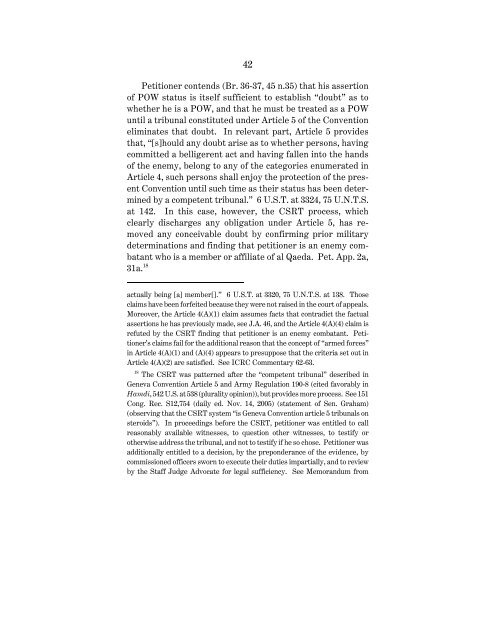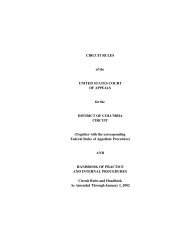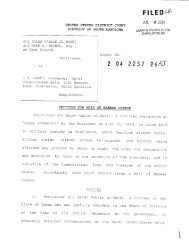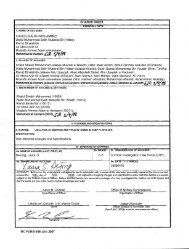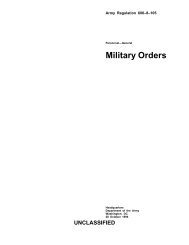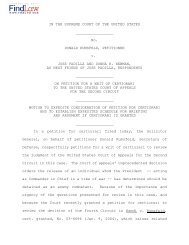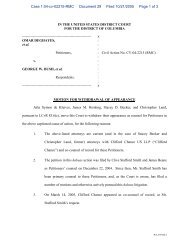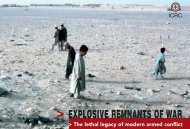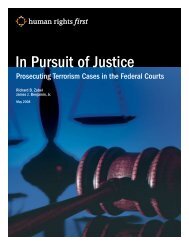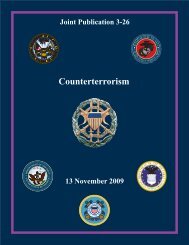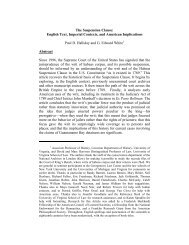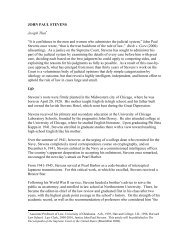Government Merits Brief - Hamdan v. Rumsfeld
Government Merits Brief - Hamdan v. Rumsfeld
Government Merits Brief - Hamdan v. Rumsfeld
Create successful ePaper yourself
Turn your PDF publications into a flip-book with our unique Google optimized e-Paper software.
42<br />
Petitioner contends (Br. 36-37, 45 n.35) that his assertion<br />
of POW status is itself sufficient to establish “doubt” as to<br />
whether he is a POW, and that he must be treated as a POW<br />
until a tribunal constituted under Article 5 of the Convention<br />
eliminates that doubt. In relevant part, Article 5 provides<br />
that, “[s]hould any doubt arise as to whether persons, having<br />
committed a belligerent act and having fallen into the hands<br />
of the enemy, belong to any of the categories enumerated in<br />
Article 4, such persons shall enjoy the protection of the present<br />
Convention until such time as their status has been determined<br />
by a competent tribunal.” 6 U.S.T. at 3324, 75 U.N.T.S.<br />
at 142. In this case, however, the CSRT process, which<br />
clearly discharges any obligation under Article 5, has removed<br />
any conceivable doubt by confirming prior military<br />
determinations and finding that petitioner is an enemy combatant<br />
who is a member or affiliate of al Qaeda. Pet. App. 2a,<br />
31a. 18<br />
actually being [a] member[].” 6 U.S.T. at 3320, 75 U.N.T.S. at 138. Those<br />
claims have been forfeited because they were not raised in the court of appeals.<br />
Moreover, the Article 4(A)(1) claim assumes facts that contradict the factual<br />
assertions he has previously made, see J.A. 46, and the Article 4(A)(4) claim is<br />
refuted by the CSRT finding that petitioner is an enemy combatant. Petitioner’s<br />
claims fail for the additional reason that the concept of “armed forces”<br />
in Article 4(A)(1) and (A)(4) appears to presuppose that the criteria set out in<br />
Article 4(A)(2) are satisfied. See ICRC Commentary 62-63.<br />
18 The CSRT was patterned after the “competent tribunal” described in<br />
Geneva Convention Article 5 and Army Regulation 190-8 (cited favorably in<br />
Hamdi, 542 U.S. at 538 (plurality opinion)), but provides more process. See 151<br />
Cong. Rec. S12,754 (daily ed. Nov. 14, 2005) (statement of Sen. Graham)<br />
(observing that the CSRT system “is Geneva Convention article 5 tribunals on<br />
steroids”). In proceedings before the CSRT, petitioner was entitled to call<br />
reasonably available witnesses, to question other witnesses, to testify or<br />
otherwise address the tribunal, and not to testify if he so chose. Petitioner was<br />
additionally entitled to a decision, by the preponderance of the evidence, by<br />
commissioned officers sworn to execute their duties impartially, and to review<br />
by the Staff Judge Advocate for legal sufficiency. See Memorandum from


